Korean Army Stew with spam and cheese is the 1950s Korean-American classic that has it all.
Rich kimchi-flavored broth. Salty spam, hot dog, and bacon. Healthyish tofu and mushrooms. Bouncy, chewy noodles and rice cakes (Yes, two kinds of carbs).
And finally, for even more indulgence, it’s all topped off with melty American cheese.
There’s definitely a lot going on in this dish. And that’s what makes it such an epic meal.
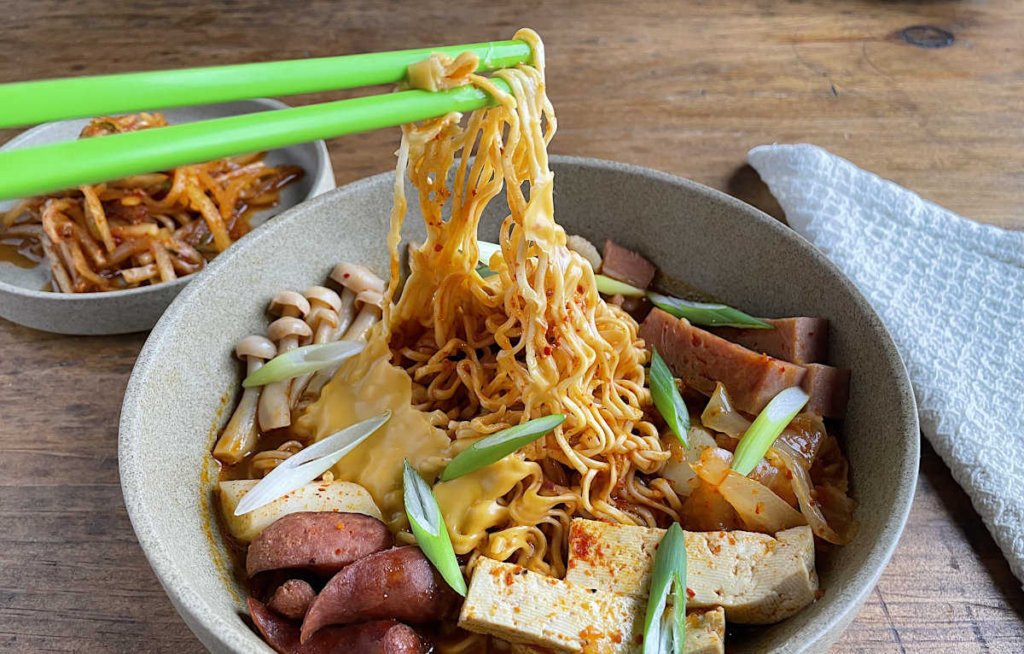
What is Korean Army Stew
Korean Army Stew, or Budae Jjigae, was invented in Korea sometime shortly after the armistice of the 1950s Korean war.
The name “Army Stew” refers to the American ingredients of spam, hot dog, bacon and cheese that were brought to Korea by the American military. There was a surplus of these ingredients after the war ended, and they found their way into Korean recipes.
Korean Army Stew is considered to be one of the first Korean-Western fusion dishes made. It’s still popular today, along with many other Korean-Western fusion recipes (such as Rose Tteokbokki and Bulgogi Kimchi Pasta).
A collision of flavors and textures
The best part about Korean Army Stew is that it has so many different toppings with so many contrasting textures and flavors. No bite is ever the same.
I personally loved combining some of the toppings into one single bite!
Try a bite with mushroom, bacon, and rice cakes.
Next try out tofu, kimchi, and some scallions.
And next try noodles and spam.
And on and on. It all makes for a really fun eating experience that never gets old.

Ingredients in Korean Army Stew with Spam and Cheese
Toppings
Spam, hot dogs, and bacon. Salty, savory processed meats are the defining ingredients of this stew and can’t be skipped.
Tofu. Tofu absorbs the flavor of the broth and provides a soft texture that contrasts against the other ingredients.
Shimeji Mushrooms. This recipe uses shimeji mushrooms. If you have trouble finding them, almost any other kind of mushroom would work. Get creative and add a mix of enoki, shiitake, king oyster, or even button mushrooms.
Instant ramen noodles. Fast-cooking instant ramen noodles soak up the delicious broth and add to the kitchy nostalgia of the dish.
Rice cakes. Add even more carbs with bouncy, chewy rice cakes.
American cheese. The best part about using American cheese is that it dissolves into the broth, adding creaminess and saltiness.
Broth
Dashi. Using dashi powder to create a quick broth speeds up the cooking process and adds an instant punch of umami.
Gochugaru. Gochugaru adds a spicy, slightly fruity flavor to the broth and gives it a deep red color. It isn’t as spicy as it looks.
Rice wine. This recipe uses Chinese rice wine, but any kind of rice wine would work. If you don’t have a rice wine on hand, it can be skipped. Avoid using rice wine vinegar.
Soy sauce. Soy sauce adds saltiness to the broth.
Sugar. Sugar adds some sweetness.
Garlic. Garlic is the only aromatic used in the broth. No onions or ginger here.
Gochujang. The Korean fermented paste adds an amazing undertone of sweetness, spiciness and savoriness. Gochujang is now popular in the United States and can be found in most grocery stores. Amazon also carries it.
Spam and cheese in Korean food?
Yes!
Cheese has become incredibly popular in Korea, especially among typical bar food.
And spam, while no longer used very often in most of the US, remains popular throughout many countries in Asia and the Pacific.
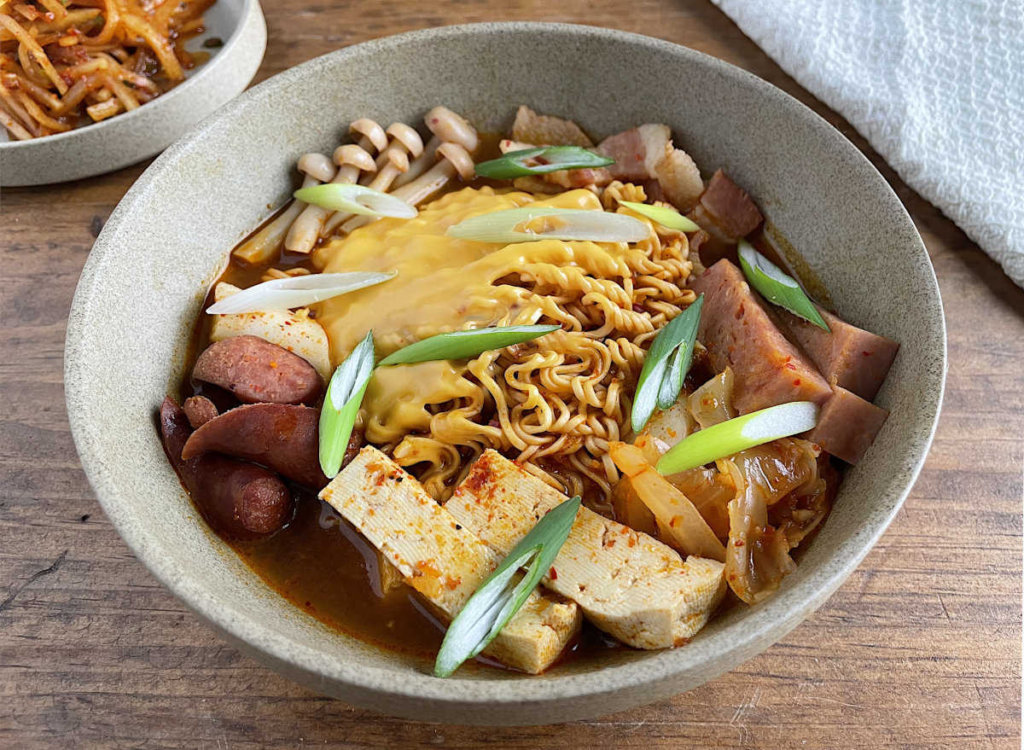
How to make Korean Army Stew
Prepare the toppings by chopping them into bite-sized pieces. Chop the bacon into 1.5” slices. Chop the miniature hot dogs in half. Slice spam and tofu into 1 ½” pieces. Chop the rice cakes in half. Chop the root ends off of the shimeji mushrooms and discard. Slice the scallions.
Make the sauce. Mix gochugaru, rice wine, soy sauce, minced garlic, sugar, gochujang, and black pepper in a small bowl until combined.
Make the dashi. Mix dashi powder and 3 cups water into a medium bowl, and stir until dissolved.
Add toppings to the pot. Add all ingredients except for the sauce, dashi, rice cakes, noodles, cheese, and scallions to the pot.
Next add the sauce and dashi. First add the sauce to the middle of the pot. Then add the dashi to the side of the pot, without disturbing the sauce.
Cook. Cover the pot and cook on the stove for 8 minutes over medium heat.
Add the noodles, rice cakes and cheese. Add the instant ramen noodles and rice cakes to the stew. Lay the American cheese slices directly on top of the noodles. Cook uncovered for 2-3 minutes.
Garnish and serve. Garnish the stew with the sliced scallions and serve right away.
Tips for making Korean Army Stew
- Cut all the ingredients into bite-sized pieces. Cut all the ingredients into smaller, bite-sized pieces so they can be easily eaten. If you cut the ingredients into smaller pieces, you can also eat a few different things in one bite, creating nice flavor and texture combinations.
- Don’t overcook the ramen noodles. Overcooking the noodles will make them soggy. Cook the noodles for just 2-3 minutes, until they’re beginning to soften. Once you take the stew off the heat, the noodles will continue to cook and will begin to soak up the broth.
- Use refrigerated rice cakes, rather than frozen ones. Refrigerated rice cakes cook quicker than frozen ones and don’t splinter while they cook.
What else can I add into Korean Army Stew?
Korean Army Stew is very easily customized to your liking.
It was originally made with whatever was on hand, even using pineapple at some point. Here are some other ideas:
- Canned baked beans
- Napa cabbage
- Red bell pepper
- Ground pork
- Frozen dumplings or wontons
- Frozen corn
Spam, hot dogs, and bacon is a lot of meat. Do I need to use all of these?
This recipe is really flexible and can be customized however you like.
Want to skip the bacon? No problem.
But try to use at least one of these meats, or it won’t be a true Army Stew.
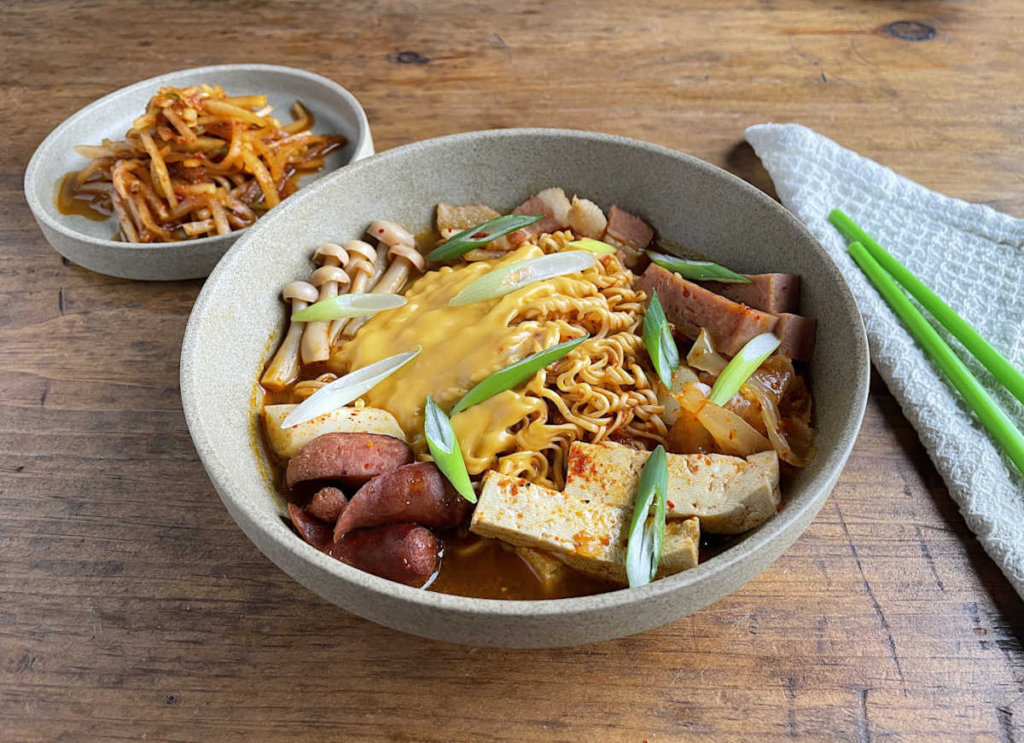
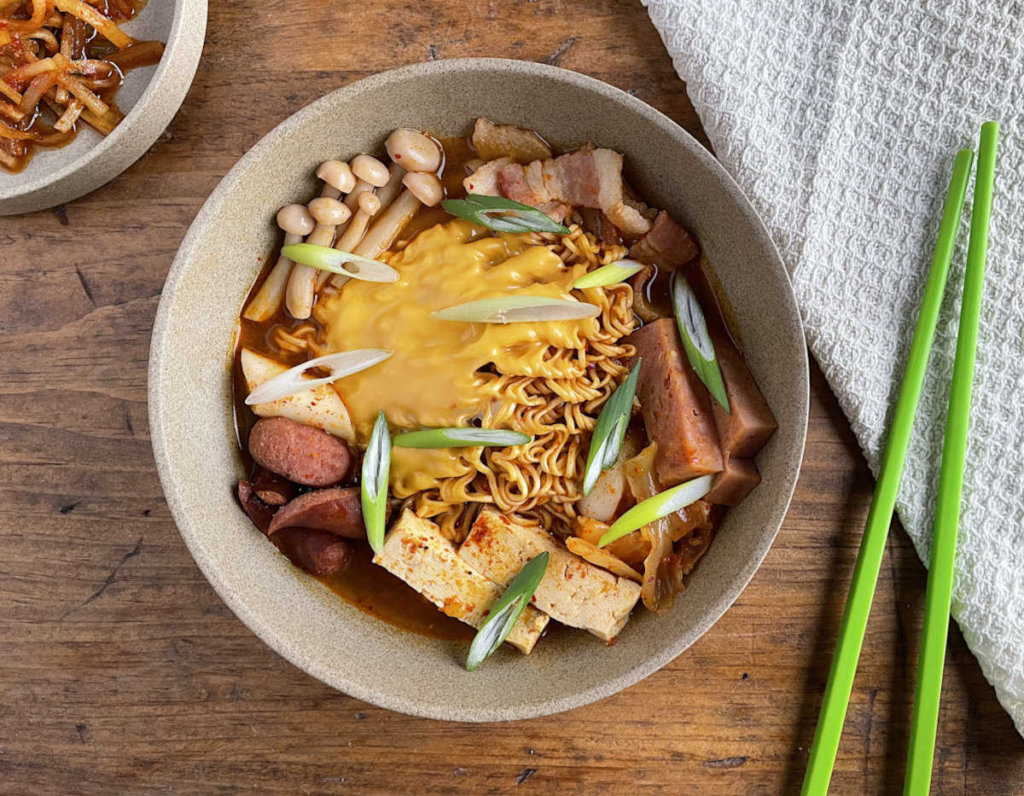
Why American cheese?
Some Army Stew recipes call for using more high quality cheeses like cheddar.
But I completely recommend using American cheese for this recipe.
American cheese dissolves super quickly into the broth, creating even more flavor. You’ll end up with a richer, creamier, saltier both.
Resist the urge to go fancy and stick with the classic!
How to serve Korean Army Stew with Spam and Cheese?
If you have a countertop burner, you can use it right at the table, hot pot-style, to keep the stew warm and bubbling.
If you don’t have one, just serve the stew in individual bowls like any other soup.
What to serve with Korean Army Stew
Since Korean Army Stew already has so many different ingredients and flavors, it’s best to serve it alongside lighter sides.
Rice. Korean Army Stew is usually served with white steamed rice.
Moochae. The Korean radish salad dish adds a fresh, crunchy contrast against the rich stew.
Pickle. Round out your meal with the brightness of a pickle, such as this quick pickled celery.
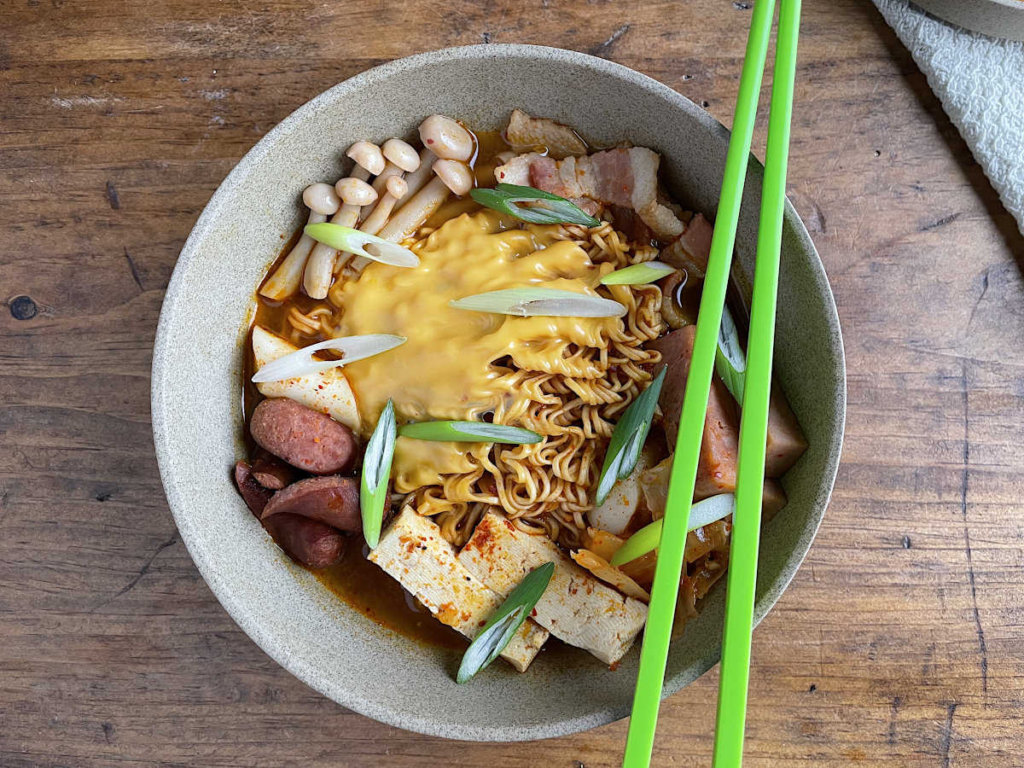
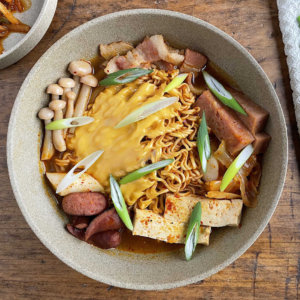
Korean Army Stew with Spam and Cheese
Ingredients
For the sauce
- 1 ½ tbsp gochugaru
- 1 ½ tbsp rice wine
- 2 tsp soy sauce
- 2 tsp minced garlic
- 1 tsp sugar
- 1 ½ tsp gochujang
- 10-12 grinds black pepper
For the stew
- 1 tbsp dashi powder
- 2 oz spam
- 6 miniature hot dogs
- 1 strip bacon
- ¼ cup kimchi
- 1 handful shimeji mushrooms about 10-15 mushrooms
- 1 package instant ramen noodles
- 1/2 cup Korean rice cakes
- 2 slices American cheese
- 2 scallions sliced on a bias, to garnish
Instructions
Prepare the stew toppings
- Slice the spam into 1 ½” pieces.
- Chop the bacon crosswise into 1" pieces.
- Chop the miniature hot dogs in half.
- Slice the tofu into 1 ½” pieces.
- Roughly chop the kimchi.
- Chop the rice cakes in half.
- Chop off the root ends of the shimeji mushrooms and discard.
Make the sauce
- Mix the gochugaru, rice wine, soy sauce, minced garlic, sugar, gochujang, and black pepper in a small bowl until combined.
Make the dashi
- Combine the dashi powder with 3 cups water in a medium bowl, and stir until dissolved.
Cook the stew
- Add all ingredients except for the sauce, dashi, rice cakes, noodles, cheese, and scallions to the pot.
- Add the sauce to the middle of the pot.
- Add the dashi to the side of the pot, without disturbing the sauce.
- Cover the pot and cook on the stove for 8 minutes over medium heat. The stew will begin to boil.
- Add the instant ramen noodles and rice cakes to the pot. Lay the American cheese slices directly on top of the noodles.
- Cook uncovered for 2-3 minutes.
Garnish and serve
- Garnish the stew with the sliced scallions and serve right away.

[…] course: Set these sprouts down next to spicy, cheesy Korean dishes such as Rose Tteokbokki or Army Stew, and you’ll have a super indulgent and satisfying […]